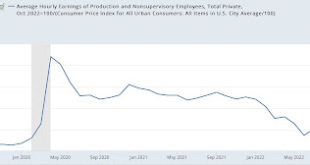There are encouraging signs that Canada’s economy and labour market are improving after a period of stagnation brought about by the Bank of Canada’s aggressive interest rate hikes in 2022 and 2023. Newly released data for the third quarter of 2024 (July-September) shows the economy has continued to grow, albeit slowly. Consumer spending was the brightest light in the third quarter data: growing at an annualized rate of 3.5% (in real, inflation-adjusted terms), and constituting the...
Read More »Wage Growth Is Declining Across Sectors, but Not at the Same Rate
This particular graph was pulled from an April 2024 Morning Star article. The source of it being the Bureau of Labor Statistics. It depicts wage growth before during and after the Pandemic. In particular I believe the government did quite well in providing for and protecting its citizens during the pandemic when many people could not work. The stimulus packages may have caused some of the wage growth and inflation. There are other things which are...
Read More »“If things are good, then why do I still have nothing left over?”
Angry Bear: I have been bugging Daniel to write on occasion for Angry Bear. Daniel did write occasionally and his commentaries were good. I know it is a burden. Well, here is one of Daniel’s comments. A good one as usual . . . I believe the interest costs are part of the story as to the perception of inflation. Within that, so what if wages kept pace with rising costs (excluding interest), all it means is the person stayed even while hearing how...
Read More »Wage Passthrough to Pricing is Minimal and Abating
This commentary is along the lines of what I have been taught when I was consulting with Ingersoll Engineers in Rockford and which is now extinct. My background includes manufacturing planning at all levels domestically and internationally for US and foreign companies. Labor’s wages are a small part of the Cost of Manufacturing, etc. Spencer England and I went round and round on this topic. Manufacturing, Inventory and Throughput planning was my...
Read More »How is the working-middle class doing? Real average non-supervisory wages
Real average hourly wages and real aggregate payrolls for October – by New Deal democrat With yesterday’s report on October consumer prices, we can take up two of my favorite measures of how the working/middle class is doing – real average non-supervisory wages, and real aggregate payrolls. Real average wages for non-supervisory workers declined -0.1% for the month. They are -5% below their pandemic lockdown peak (which, recall, was...
Read More »Much stronger conditions needed on federal wage subsidy program
The federal government has announced it is prepared to pay wages subsidies of up to 75% of employee wages for all private businesses and other employers, including non-profits, partnerships and charities that expect a 30% drop in revenues, up to a maximum of $847/worker per week and $11,011 over the three months. The previously announced 10% wage subsidy was only available for smaller employers. There’s no question about it: this is a massive commitment that is likely to be the most...
Read More »Much stronger conditions needed on federal wage subsidy program
The federal government has announced it is prepared to pay wages subsidies of up to 75% of employee wages for all private businesses and other employers, including non-profits, partnerships and charities that expect a 30% drop in revenues, up to a maximum of $847/worker per week and $11,011 over the three months. The previously announced 10% wage subsidy was only available for smaller employers. There’s no question about it: this is a massive commitment that is likely to be the most...
Read More »Making the COVID19 Wage Subsidy Program work better for workers
With the federal government is increasing its temporary wage subsidy to 75%, other reforms are needed to ensure the public funding goes to maintain workers, and not pad the profits of businesses. In the face of the COVID19 crisis, the Canadian government has done a very good job of both limiting the spread of the virus and putting in place measures to prevent a health pandemic from also turning into an economic pandemic. On the economic side, Prime Minister Trudeau and Finance...
Read More »Making the COVID19 Wage Subsidy Program work better for workers
With the federal government is increasing its temporary wage subsidy to 75%, other reforms are needed to ensure the public funding goes to maintain workers, and not pad the profits of businesses. In the face of the COVID19 crisis, the Canadian government has done a very good job of both limiting the spread of the virus and putting in place measures to prevent a health pandemic from also turning into an economic pandemic. On the economic side, Prime Minister Trudeau and Finance...
Read More »Ten things to know about the 2019-20 Alberta budget
I’ve just written a ‘top 10’ overview of the recent Alberta budget. Points raised in the post include the following: -The budget lays out a four-year strategy of spending cuts, letting population growth and inflation do much of the heavy lifting. -After one accounts for both population growth and inflation, annual provincial spending in Alberta by 2022 is projected to be 16.2% lower than it was last year. -Alberta remains Canada’s lowest-taxed province. It also...
Read More » Heterodox
Heterodox


